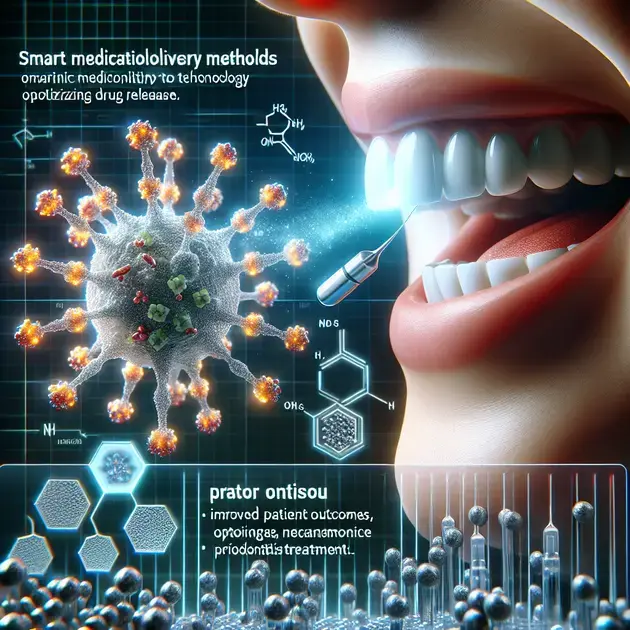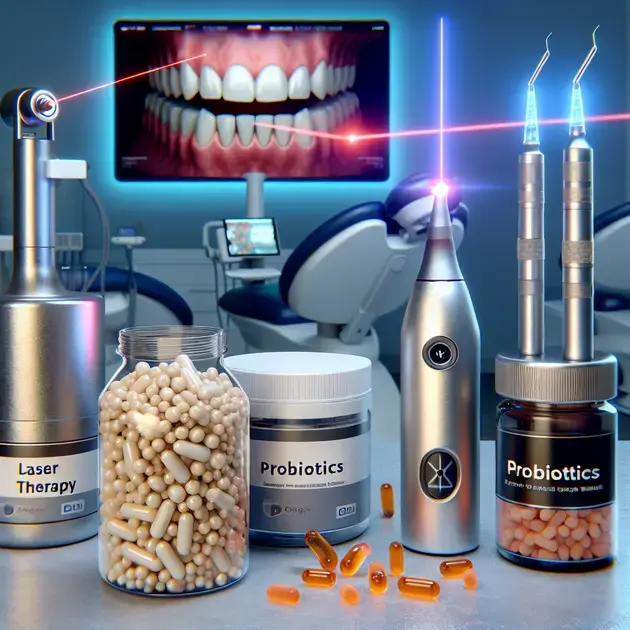When it comes to periodontitis treatment, understanding medication options is crucial for managing this chronic inflammatory condition effectively. Periodontitis is a serious gum infection that can damage the soft tissue and destroy the bone supporting the teeth. In recent years, several medication options have emerged to help combat periodontitis and improve oral health.
From antimicrobial mouth rinses to antibiotics and prescription-strength toothpaste, there are various medication choices available for individuals suffering from periodontitis. It’s essential to work closely with a dental professional to determine the most suitable treatment plan based on the severity of the condition and individual health needs. By gaining a better understanding of these medication options, patients can take proactive steps towards combating periodontitis and preserving their oral health.

Understanding Non-Surgical Medication Options
In the realm of dental care, non-surgical medication options play a crucial role in managing various oral health issues. Understanding these options can help patients make informed decisions about their treatment plans. Below is a step-by-step guide on how to explore and utilize non-surgical medication options:
Educate Yourself:
Start by researching reputable sources such as the American Dental Association website or the Mayo Clinic app to learn about the different non-surgical medication options available. Understand their benefits, potential side effects, and how they can complement other dental treatments.
Consult with Your Dentist:
Once you have gathered information, schedule a consultation with your dentist. Discuss your findings and concerns, and work together to determine the most suitable non-surgical medication options for your specific dental needs.
Follow Prescribed Guidelines:
If your dentist prescribes a non-surgical medication, make sure to carefully read and follow the dosage and usage instructions. Utilize reminder apps like Medisafe or MyTherapy to help you stay on track with your medication schedule.
Monitor Your Progress:
Regularly monitor the effects of the non-surgical medication on your oral health. Keep a journal or use a health tracking app like Symple or Bearable to record any changes or improvements you notice.
Communicate with Your Dental Team:
Stay in touch with your dentist and dental hygienist throughout the treatment process. Inform them of any concerns or side effects you experience, and collaborate on adjusting your medication plan if necessary.
Exploring Antibiotic Treatments
Antibiotic treatments are commonly used in dentistry to manage infections, prevent complications, and promote oral health. Exploring antibiotic treatments involves a systematic approach to ensure their effectiveness and safety. Here’s a detailed guide on how to navigate antibiotic treatments:
Get Informed:
Start by accessing reliable sources such as the Centers for Disease Control and Prevention website or the Drugs.com app. Educate yourself on the different types of antibiotics used in dentistry, their indications, and potential interactions.
Consultation with a Specialist:
If your dental issue requires antibiotic treatment, consult with a dental specialist. They can provide expert advice on the most suitable antibiotic for your condition and guide you through the treatment process.
Follow Proper Dosage:
When prescribed antibiotics, ensure you understand the correct dosage and duration of the treatment. Use medication reminder apps like Mango Health or Round Health to set alarms for taking your antibiotics on time.
Monitor Side Effects:
Be vigilant about any potential side effects of antibiotics and communicate them to your dental provider promptly. Keep a symptom tracker using apps like Healthie or CareClinic to monitor your health status during antibiotic treatment.
Complete the Full Course:
It’s essential to complete the full course of antibiotic treatment as prescribed, even if your symptoms improve. This helps prevent antibiotic resistance and ensures the infection is fully eradicated.
Collaborating with Dental Professionals
Effective collaboration with dental professionals is key to maintaining optimal oral health and receiving comprehensive care. This involves mutual communication, trust, and shared decision-making. Here’s a guide on how to collaborate effectively with dental professionals:
Establish Open Communication:
Build a relationship based on open communication with your dental team. Share your concerns, preferences, and medical history to help them tailor the treatment to your individual needs. Use secure messaging apps like Klara or Lighthouse 360 to stay in touch with your dental providers.
Attend Regular Check-Ups:
Regular dental check-ups are essential for preventive care and early detection of oral health issues. Schedule and attend routine appointments with your dentist and hygienist to maintain optimal oral hygiene.
Follow Treatment Recommendations:
Trust the expertise of your dental professionals and follow their treatment recommendations diligently. Use medication management apps like Dosecast or Round Health to keep track of prescribed medications and follow-up appointments.
Ask Questions:
Don’t hesitate to ask questions or seek clarifications about your treatment plan or oral health concerns. Engage in discussions with your dental team to ensure you have a clear understanding of the recommended procedures and their benefits.
Provide Feedback:
Share feedback with your dental professionals about your treatment experience and any suggestions for improvement. Your input can help enhance the quality of care and strengthen the collaborative relationship between you and your dental team.

Exploring Novel Medication Delivery Methods
When it comes to treating periodontitis, novel medication delivery methods are constantly being developed to improve efficacy and patient comfort. One innovative approach is the use of biodegradable drug-eluting microspheres, which can release medication directly into the affected gum tissues over a sustained period of time. This targeted delivery system not only enhances the effectiveness of the medication but also reduces the need for frequent applications, making it more convenient for patients.
Another promising advancement in medication delivery is the development of smart drug delivery systems. These systems are designed to respond to the specific conditions in the oral cavity, such as pH levels and bacterial presence, to release the medication at the optimal time and dosage. By utilizing smart technology, clinicians can ensure that the medication reaches the target site effectively, leading to better treatment outcomes.
Nanotechnology is also playing a key role in revolutionizing medication delivery for periodontitis. Nanoparticles can be engineered to encapsulate drugs and penetrate the biofilm that forms on the gum tissues, delivering the medication directly to the infection site. This targeted approach reduces systemic side effects and improves the overall efficiency of the treatment.
Furthermore, the use of microneedles for medication delivery is gaining traction in periodontal care. These tiny needles can painlessly penetrate the gum tissues to deliver medication or vaccines with precision. Microneedle patches offer a minimally invasive and potentially more effective alternative to traditional injection methods, making them an exciting prospect for the future of periodontitis treatment.
Overall, exploring novel medication delivery methods demonstrates the continuous innovation in the field of periodontal care, offering new possibilities for enhancing treatment outcomes and patient experience.
Embracing Innovative Periodontitis Treatments
In the realm of periodontal care, embracing innovative treatments is essential for effectively managing and treating periodontitis. One such innovative approach is the use of laser therapy for gum disease. Laser technology can target and eliminate bacteria in the gum pockets with precision, promoting faster healing and reduced inflammation. This non-invasive treatment option is gaining popularity for its effectiveness and minimal discomfort for patients.
Another innovative treatment for periodontitis is the use of probiotics to restore the balance of oral microbiota. By introducing beneficial bacteria into the oral cavity, probiotics can help inhibit the growth of harmful pathogens that contribute to gum disease. Incorporating probiotic supplements or foods into the treatment plan can support long-term gum health and reduce the risk of disease progression.
Platelet-rich plasma (PRP) therapy is also emerging as a promising treatment for periodontitis. PRP is rich in growth factors that can accelerate tissue regeneration and wound healing in the gums. By applying PRP directly to the affected areas, clinicians can promote faster recovery and tissue repair, leading to improved periodontal health.
Furthermore, ozone therapy has shown potential as an innovative treatment for periodontitis. Ozone gas can effectively kill bacteria and disinfect the gum tissues, reducing inflammation and promoting healing. This non-invasive therapy can be used in conjunction with traditional treatments to enhance outcomes and improve overall oral health.
By embracing these innovative periodontitis treatments, clinicians can provide patients with advanced care options that prioritize effectiveness, comfort, and long-term oral health.
Enhancing Periodontal Care with Advanced Therapies
Periodontal care continues to evolve with the development of advanced therapies that aim to enhance treatment outcomes and improve patient satisfaction. One such therapy is guided tissue regeneration, a surgical technique that promotes the regeneration of damaged gum and bone tissues. By using barrier membranes to protect the root surface and promote tissue growth, clinicians can effectively repair the damage caused by periodontitis and restore oral health.
Regenerative medicine offers another avenue for enhancing periodontal care through the use of growth factors and stem cells to stimulate tissue repair and regeneration. These biologic agents can support the natural healing process in the gums and bone, leading to improved outcomes for patients with advanced periodontitis. By harnessing the body’s own regenerative capabilities, regenerative medicine holds great promise for the future of periodontal therapy.
Photodynamic therapy is also gaining recognition as an advanced treatment option for periodontitis. By combining a photosensitizing agent with laser light, clinicians can selectively target and destroy bacteria in the gum tissues while preserving healthy cells. This targeted approach can help reduce inflammation, promote healing, and improve the overall health of the gums.
Additionally, air polishing technology is revolutionizing the way dental professionals remove plaque and biofilm from the teeth and gums. This advanced cleaning method uses a combination of water, air, and fine powder particles to gently polish the teeth and remove stubborn deposits. Air polishing offers a comfortable and efficient alternative to traditional scaling and root planing, enhancing the overall experience for patients undergoing periodontal maintenance.
By embracing these advanced therapies, clinicians can elevate the standard of periodontal care, providing patients with innovative treatment options that prioritize optimal outcomes and long-term oral health.
Conclusion
Exploring novel medication delivery methods in periodontal care showcases the ongoing innovation aimed at enhancing treatment efficacy and patient comfort. From biodegradable drug-eluting microspheres to smart drug delivery systems, nanotechnology, and microneedles, the field is progressing towards targeted and efficient solutions. These advancements not only improve medication effectiveness but also reduce the burden of frequent applications, offering convenience to patients while enhancing treatment outcomes.
Embracing innovative treatments for periodontitis, such as laser therapy, probiotics, platelet-rich plasma (PRP) therapy, and ozone therapy, presents advanced options for managing gum disease effectively. These treatments focus on precision, microbial balance restoration, tissue regeneration, and bacteria elimination, ultimately prioritizing patient comfort and long-term oral health. By incorporating these innovative approaches into clinical practice, clinicians can provide personalized and effective care to patients with periodontitis.
Enhancing periodontal care with advanced therapies like guided tissue regeneration, regenerative medicine, photodynamic therapy, and air polishing technology marks a significant evolution in treatment modalities. These therapies promote tissue repair, regeneration, selective bacterial elimination, and efficient plaque removal, boosting treatment outcomes and patient satisfaction. By staying abreast of these cutting-edge advancements and integrating them into practice, dental professionals can elevate the standard of care, ensuring optimal results and long-term oral health for their patients.



